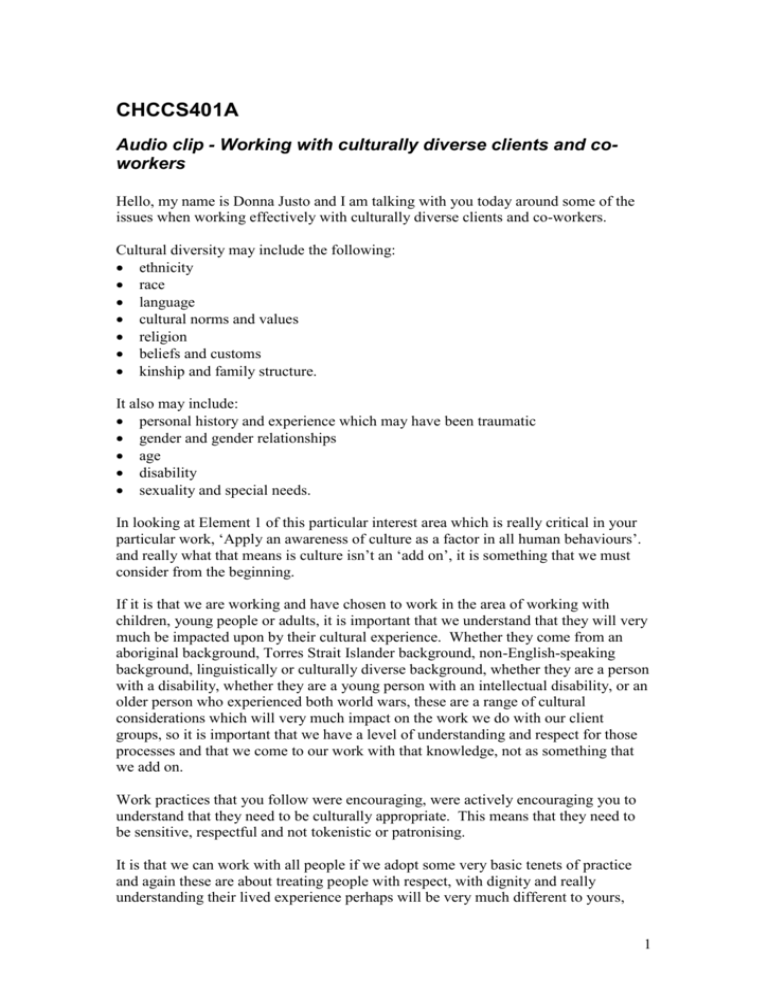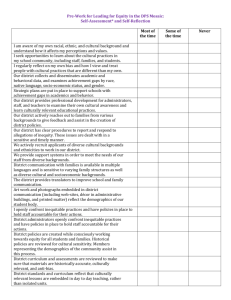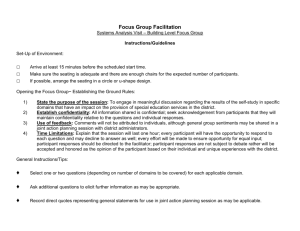transcript (Word Document 49KB)
advertisement

CHCCS401A Audio clip - Working with culturally diverse clients and coworkers Hello, my name is Donna Justo and I am talking with you today around some of the issues when working effectively with culturally diverse clients and co-workers. Cultural diversity may include the following: ethnicity race language cultural norms and values religion beliefs and customs kinship and family structure. It also may include: personal history and experience which may have been traumatic gender and gender relationships age disability sexuality and special needs. In looking at Element 1 of this particular interest area which is really critical in your particular work, ‘Apply an awareness of culture as a factor in all human behaviours’. and really what that means is culture isn’t an ‘add on’, it is something that we must consider from the beginning. If it is that we are working and have chosen to work in the area of working with children, young people or adults, it is important that we understand that they will very much be impacted upon by their cultural experience. Whether they come from an aboriginal background, Torres Strait Islander background, non-English-speaking background, linguistically or culturally diverse background, whether they are a person with a disability, whether they are a young person with an intellectual disability, or an older person who experienced both world wars, these are a range of cultural considerations which will very much impact on the work we do with our client groups, so it is important that we have a level of understanding and respect for those processes and that we come to our work with that knowledge, not as something that we add on. Work practices that you follow were encouraging, were actively encouraging you to understand that they need to be culturally appropriate. This means that they need to be sensitive, respectful and not tokenistic or patronising. It is that we can work with all people if we adopt some very basic tenets of practice and again these are about treating people with respect, with dignity and really understanding their lived experience perhaps will be very much different to yours, 1 because perhaps they might be experts in their own lived experience and we need to value that. We need to understand too that people from other cultural groups are employed, perhaps, in the organisation, they inform your organisation and are very much key stakeholders about understanding those experiences and have much to share with you. The work practices that are followed create a culturally and psychologically safe environment for all persons. This ensures that all persons that you engage with in all processes understand the need for specific workers from that culture to accompany you where possible. Now sometimes it’s not possible to actually have workers from all 172 cultures working in your organisation or in your region. However, it might be possible to have someone from a language group hooked up via interpreter. It might be possible to have someone from an agency who has been used to working with people who are immigrants. It might be possible to have an Aboriginal colleague from another agency or a Torres Strait Islander health worker or a child protection worker or a child and family support worker accompany you on your work. This really ensures that you are providing that support. There is, I think, much more understanding around the issue of gender these days in that if we are working with a woman, it might be that she actually prefers to speak with a woman. If we are working with a man, he might prefer to speak with another male worker. However, the challenge for us is that ideally, we must ask and then where possible attempt to fulfil their request and support choices they make. That you also consider the extra complexities of gender, as I have mentioned. Sexuality, whether the person is lesbian, gay, bisexual or transgender. This will very much impact on their lived experiences and needs to be considered as part of the process. Their age, whether they are a child or a young person, or in their late 70s and other relevant issues. Another consideration that this competency asks you to consider is how you contribute to the development of relationships based on cultural diversity. What we are saying here is that respect for cultural diversity is demonstrated in all of your communications and interactions with clients, colleagues, customers, etc.– all of those who you come in contact with. So again, it is about that behaviour on your part. Not being tokenistic. It is where you really value and appreciate difference. It is not about tolerating it. Tolerating it means simply that you are tolerating it. Tolerance is not what we’re looking for. We are looking for understanding and we are looking for commitment to having total cultural inclusion, despite our issues of diversity. Specific strategies are used by you to eliminate any bias and discrimination in dealing with clients and co-workers. Some of these examples might include cross-cultural work teams . I gave you an example of that before and that might be where you might be, as an example, an anglo-Australian worker and you might choose regularly to go into an Aboriginal community with Aboriginal colleagues from that community. So you are working alongside of them to support your client group within that community. In particular, as an example, where that is in a child protection area, or you might be working in a domestic violence or family violence agency. 2 That cross-cultural employee representation on committees is reflected also. So that, as an example, you are a non-government organisation or sit as part of a justice group or steering group that you certainly have representation from all of the relevant groups that sit in that community. That where possible as employers that you actively seek employees from Aboriginal backgrounds, Torres Strait Islander backgrounds or non-English-speaking backgrounds, because this will also send a very clear message to your client group that you definitely want to engage with those groups and that you understand that it might be appropriate for them to seek out people from their own cultural group. However, again, choice and options are very important because some people from a specific cultural group might choose to link with a mainstream worker because they might be concerned about issues of confidentiality or privacy. It is important that we understand that point. Important too as I state next to you that your workplace is free of culturally insensitive literature, posters and signage and that we be really conscious of jokes or other informal asides that might be denigrating. Other experiences too that we might be concerned with are where people have had, I think, challenging situations. If they are perhaps from non-English-speaking backgrounds or come from Aboriginal communities, there could be a difficulty in interacting perhaps with justice authorities, or you might need to be sensitive about perhaps a meeting not taking place at a police station or a courthouse in the first instance. It might take place in a more, what could be perceived by them to be a threatening environment. For us it might be nonthreatening and so it is important that we actually set that initial meeting up to succeed by holding that meeting in a non-threatening environment. Inclusion in decision making is very critical. That people from a range of different cultural backgrounds are able to make informed decisions about what is occurring for them. To do this they might require an interpreter if they are from another language. They might be from the Torres Strait and require a Creole interpreter. They might be from Argentina and require a Spanish language interpreter. They might have no hearing and so it might be critical for them to have a representative from the Queensland Deaf Society, as an example, to interpret for them. Critical that we do this, because in particular, in the child protection area they might be talking about issues relating to legislation or the law. We might be talking about medical issues or a whole range of other very important or critical issues, so we can’t make the presumption that the person actually or actively understands. We need that clarified via an interpreter. Element 3 encourages us to look at communicating effectively with culturally diverse persons that we might be working with. Asks you to consider the following: Your verbal cues – how you respond verbally to people. Are you a good listener? Are you an acute listener? It is very important that we do that. That we don’t assume or second guess what might be coming from the person. In particular, where we are using interpreters as the third party in the process. Remember at all times that you are actively engaging with the client. 3 The client is the person that you are looking at, you’re actively engaging with and the interpreter is there purely to interpret what you are saying and to interpret for them back to you. That you use appropriate gestures and facial and physical expressions in your work. That you definitely are connected and tuned in to what is being said. That your posture shows that you are very much interested in what is occurring and that your body language isn’t reflecting that you are bored, tired, disinterested or any of those other body language cues that in fact can give very much a negative impression to the process. Also that your written communications also are very supportive, that they’re assessments as opposed to judgements. Communicate effectively with culturally diverse persons again – and consider these as well: Consider any signage that is in your workplace, and again consider the use of interpreter or another person and why I have listed that is, where possible try never to use a family member as an interpreter or another person from that community to interpret, not because we are devaluing that role but because of the quality of that interpretation. As an example you might use another professional colleague to interpret if you have no one else that you can make access with. However, it is critical to use a third party, because if a person is known to them, the person that is doing the interpreting, they might choose to do exactly that, to exactly interpret what they think the person’s saying, not what they think the person needs to say, rather than what they are actively or actually saying. So it is important for us to understand that distinction. Element 4 encourages us to look at our capacity to resolve cross-cultural misunderstandings. This is really about where we need to utilise our negotiation and conflict resolution skills to ensure there are no misunderstandings. It is very important that we actually demonstrate this, I believe, by setting up such respectful and appropriate processes in the beginning that you try to actually avoid conflict and negotiation. I mean it is not that we are actually…Sorry, I really need to clarify that. It is not that I am encouraging us to step back from negotiation. Negotiation is critical. But I am saying, if you undertake respectful, sensitive processes, if you really understand who it is that you need to work alongside with, so that your clients feel supported when you are working with culturally diverse clients, if you have taken the time to support and understand them, if interpreters are present, if you have made the commitments and kept them throughout, that will have built a certain level of trust and it will have established a relationship between that client and you. So effectively, that will have avoided conflict. Negotiations will always be part of the process. We shouldn’t be frightened of conflict. Conflict might be ever present, sometimes over the smallest issues, but we must move quickly to solve that so that it doesn’t fester and become a major issue. However, I am actually and actively encouraging you to set appropriate, sound processes in place so that in fact you are avoiding conflict because you have set up such good processes and work styles that you are not setting out to do that. I guess, sometimes a way of not respecting people from different cultural backgrounds 4 might be to arrive at their house and not knock at the door and simply to barge straight into the household. It might be to sit there in a room of elderly women from a range of different communities with your feet up on the table, chewing gum. Now all these are perhaps extreme examples I am giving you but workers have actually done this from time to time and they are disrespectful practices. So, it is really about looking at putting in place respectful processes that build to good, solid relationship building rather than allowing conflict to occur. Set the agenda, as I am saying, so that misunderstandings are avoided. Really, I wish you every success in all of your future work endeavours. 5






